Getting the Best of Your Quilting Stash – Before it Gets the Best of You
You have a sewing space and sewing supplies. The problem is that your sewing supplies will always – always – outgrow your sewing space. Unless you start corralling clutter now, your quilting stash will cheerfully bury you under a massive tidal wave.
All quilters have a stash of some sort.
A stash is any fabric that is left over from a sewing project, or fabric that you’ve bought because you’re intending to do a project that never happens, or just fabric that you fall in love with. For instance:
- I absolutely LOVE all fabric that has an autumn theme, so I have a great deal of that.
- Barb is physically incapable of passing up anything paisley, so her paisley stash is huge.
Keeping it all neat and organized is an issue that has to be answered by every seamstress. Unless you’re one of those people who work best in an environment of total chaos, then the question of organization has to be addressed for your specific situation before you can even begin to sew.
Ways that I’ve Successfully Corralled Clutter
Over time you’ll develop your own ways to corral the mess and fuss that sewing and quilting generates.
To start with, though, I like to know what I’m going to have to store – and more importantly, where I can put my hands on it when I want it. Having to search and search for something I know I have and want for a specific project frustrates me out the yin-yang and I become very unpleasant to be around.
I tend to buy ahead on any fabric I see that could be used in a fantasy type panel, so I’m always thinking of how I’m going to keep various materials that go with a specific project together and organized.
I also loathe dust and dusting, so I’m all about storing everything in closed containers. Here is what I’ve learned.
Start Corralling Clutter by Defining Your Space
Look realistically at the space that is available to you. Everyone’s situation is different and it changes with the times, so this is fluid. I like to define how far my sewing tide can spread in the space available to me.
When you’re deciding this, look at places for your:
- Sewing machine
- Ironing board
- Cutting space – typically a counter or table
- And where you will store your stash.
For years I kept my sewing machine in the bottom of a closet and brought it out to sew with on the dining room table. Now I have a desk where it sits all the time, and that is much more convenient.
For the first time ever, I also have the room to keep my ironing board set up permanently on my right side. This is a huge convenience but not at all necessary.
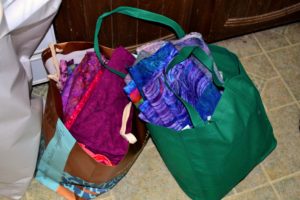
Large shopping bags can be used to corral the clutter from a particular sewing project. In this case we are using two big bags to keep the fabric, notions, and batting for a twin quilt in one easily accessed place while we work on various sections.
If you don’t have enough room for a permanent style sewing setup, make sure you put everything back every time. Otherwise it will become a habit to leave it out and soon the clutter will be driving you insane.
Keep in mind that not all of your stuff has to be all in one space.
I store my big rolls of batting and my rarely used tubs of notions in a small closet in the spare room. Barb’s sewing “room” is a small walk-in closet in her spare room and she manages to keep all her stuff neatly organized with shelves where she stacks her fabric and a peg board on the wall behind her machine to hang her thread spools on.
See if there are any cupboards, closets, drawers, or a lazy-Susan (cupboard turntable) you can commandeer for your supplies.
What about floor space or wall space?
I was getting incredibly frustrated with my space when Michael suggested he put up some wire shelves in the 3 foot space on the wall between the cupboard and window. He put up 4 short shelves for me, and that has made a huge difference to my frustration levels.
I like to keep as much of my fabric in tubs as possible.
This is because I hate dust – this solution keeps my fabric clean and – as an added bonus – easily accessible.
I took the measurements of my shelves with me to Walmart and found clear tubs that would fit in that space. Not all of my tubs are the same size. I use the larger ones for material and then I got a bunch of smaller ones that fit on top of the larger ones for each shelf. In these I keep my sewing supplies like iron cleaner, fabric glue, Velcro, markers, etc.
All of these tubs are clear so that I can see what’s in them without having to take them down and look. I also purchased a few of those plastic pullout drawer filing cabinets that Walmart carries. I set these wherever it’s convenient. I like to use the big, deep ones for storing fabric.
Organize the way that makes sense to you.
It doesn’t matter if no one else “gets” the way you corral clutter; it just has to work for you. Even if it looks like a total disaster to an outsider – who cares? You’ll know where you’re at.
I organize by theme and color. I have 3 large tubs of autumn fabric, one of landscape fabrics, a Christmas one, etc. Then I have my blue/purple tub, the teal/turquoise tub, my water fabrics tub, etc.
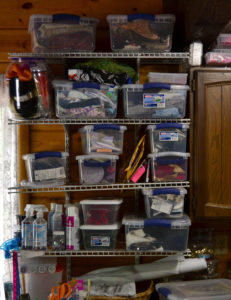
Wire shelving right above my sewing space helps keep all my most frequently used supplies, notions, and fabrics close at hand and still out of the way.
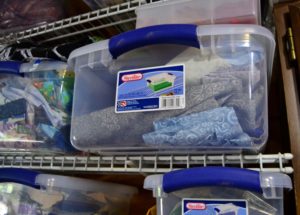
I use these fabrics frequently, 4-5 times a year. Plenty of time for them to get filthy with dust and lint unless they are kept in clear plastic storage tubs.
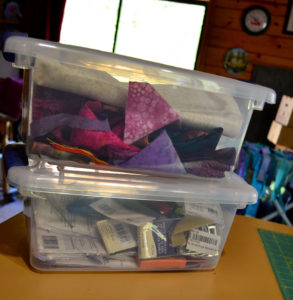
A variety of ongoing projects and sewing supplies fit great into these smaller tubs.
Corralling Notion Clutter with Genre Jars
(Leiajoy came up with the genre jar name – BTW!)
Storing notions is something you need to give a great deal of thought to. Because they’re usually smaller (like buttons and beads), or on rolls like ribbon, they can’t be stacked neatly in tubs.
I organize notions just like my fabrics – by color and theme.
A genre jar can be anything from an empty candy tub to a glass jar with a fitted lid (like the kind you use for spices in the kitchen) to a Tupperware or plastic container.
Genre jars should really be clear or clear-ish, so that you can see what’s in them, and they should also have lids (the dust, you know). Plastic works better for higher shelves – but you can use glass if you have a place to set them where they won’t be knocked off.
For small, easily lost items my solution so far has been to use the smaller plastic containers that have a whole bunch of small compartments for buttons, appliques, my thread, beads and smaller novelty items. (These are very nice because they’re relatively small and flat, so they can be stacked neatly anywhere.)
Genre jars are also perfect for things like my decorative ropes, spools of ribbon, etc. And they work well for bigger buttons, and feathers. (I know that because I’m storing feathers in preparation for a tropical project.)
Another thing I’ve found works great is a hanging shoe rack.
These are cloth tubes with sort-of-shelves inside a canvas canopy. They’re made to be hung from a ceiling hook, and the outside has small pockets that are just perfect for shoes – or fabric flowers, or large rolls of ribbon.
Plus a hanging shoe rack can be easily hung over any door.
Corralling Clutter with the “Great Thread Roundup”
I used to keep all my spools in a large wicker basket but this was a nightmare with ends tangling up and having to dig through the entire basket to find the spool I wanted.
Now I have a tub of Aurifil quilting thread. It’s a plastic tub with 2 layers (1 of large and 1 of small spools. I bought this as a set and I’ve never regretted it. It’s been 6 years now, and even though I quilt with these threads all the time, it looks as though I’ve barely started on it.
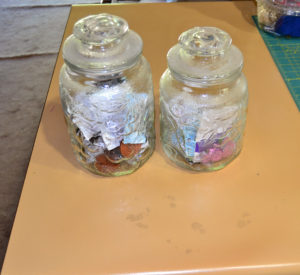
These old-fashioned crystal jars are my button genre jars. They work perfectly for keeping a variety of specialty buttons which come in odd-shaped packages.
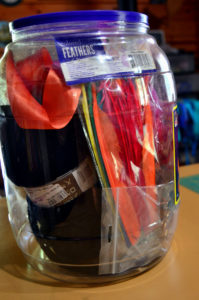
Junk food hath a few rewards. One of them being that this once-upon-a-time cheese ball jar has, after being well-washed, pressed into service as my trusty genre jar of odd-shaped supplies like a roll of yarn and faux feathers.
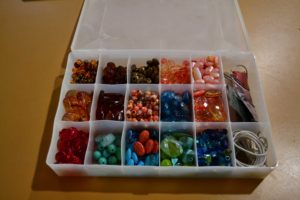
Arguably my favorite method for corralling clutter – ever! These small tubs are flat, simple, and hold those supplies that really tend to run away from you, like beads. This is also my preferred case for regular spools of thread.
I also buy a lot of specialty threads, like metallics and variegated, so I bought a deep plastic thread tub with plastic spool holders built in. This keeps those nicely corralled.
For leftover regular sized spools, I use the same plastic containers I use for my beads and buttons. I have 4 of these and I organize them by color. When I need a certain color, it’s only the work of minutes to find it. These are great because they stack easily and neatly and keep the dust off of everything.
Some threads don’t have a tie-off built into the spool. You can either stick them down with tape – a major pain – or store all these spools in a separate tub to minimize the damage.
Corralling your Sewing Supplies
For the sewing supplies that I use on an almost daily basis, I purloined a Tupperware tub from my kitchen that had lost its lid. In this I keep my scissors, pin cushion, rulers, corner turner, seam ripper, etc.
Besides being real handy, this topless solution allows me to simply grab whatever I need without bothering with lids.
Corralling Your Patterns and Books
You will inevitably end up with a great many patterns, books, and even plastic bags with your applique pieces. My system is to keep all the books on one half of a shelf on the girls’ business bookshelf.
The patterns that come in in Ziploc bags – and the applique shapes – I file in a large plastic basket that I keep in the same closet as my batting.
Here’s to Your Success in Corralling Clutter!
Whatever storage system you eventually adopt you can be sure that the ebb tide will sooner or later swell to a tidal wave and threaten to overwhelm someone else’s space.
When this happens, the only thing to do is go through everything and sort like crazy. You can’t keep everything so you have to be ruthless. Give your throwaways to friends, or a thrift store, or your quilting guild, etc.
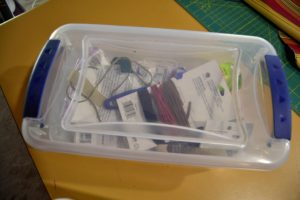
I can’t say it enough – clear plastic tubs are the way to go when it comes to corralling clutter.
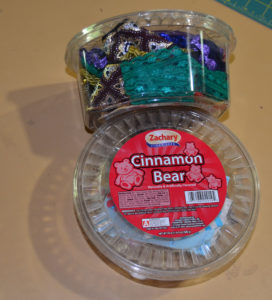
These flat plastic tubs once contained Christmas candy. But they are flat, with tight-fitting lids and they stack beautifully. I generally use them to store odds and ends like specialty ribbons and appliques.
If you don’t you’ll end up drowning under it all and that wouldn’t be very nice, now would it?
You will eventually develop a kind of working rhythm, but it’s always worthwhile to clean up every time you finish a project. You’ll be less frustrated, and your clean-up won’t be such a major pain!
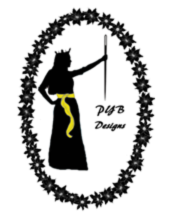
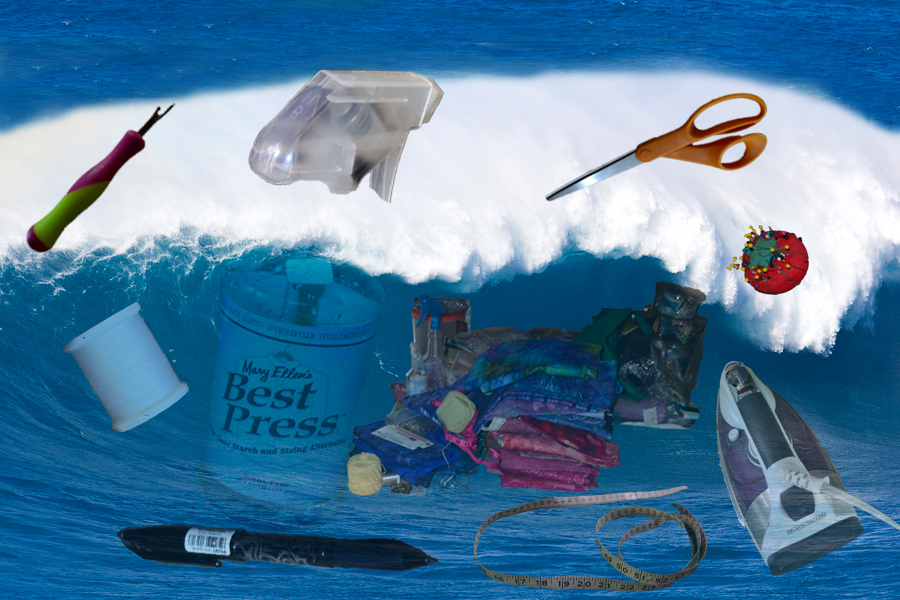
This internet site is my aspiration, rattling good design and perfect written content.
Many thanks!
yo that pst very cool
I want to to thank you for this fantastic read!! I certainly enjoyed every little bit of it.
I have you book-marked to check out new things you post…